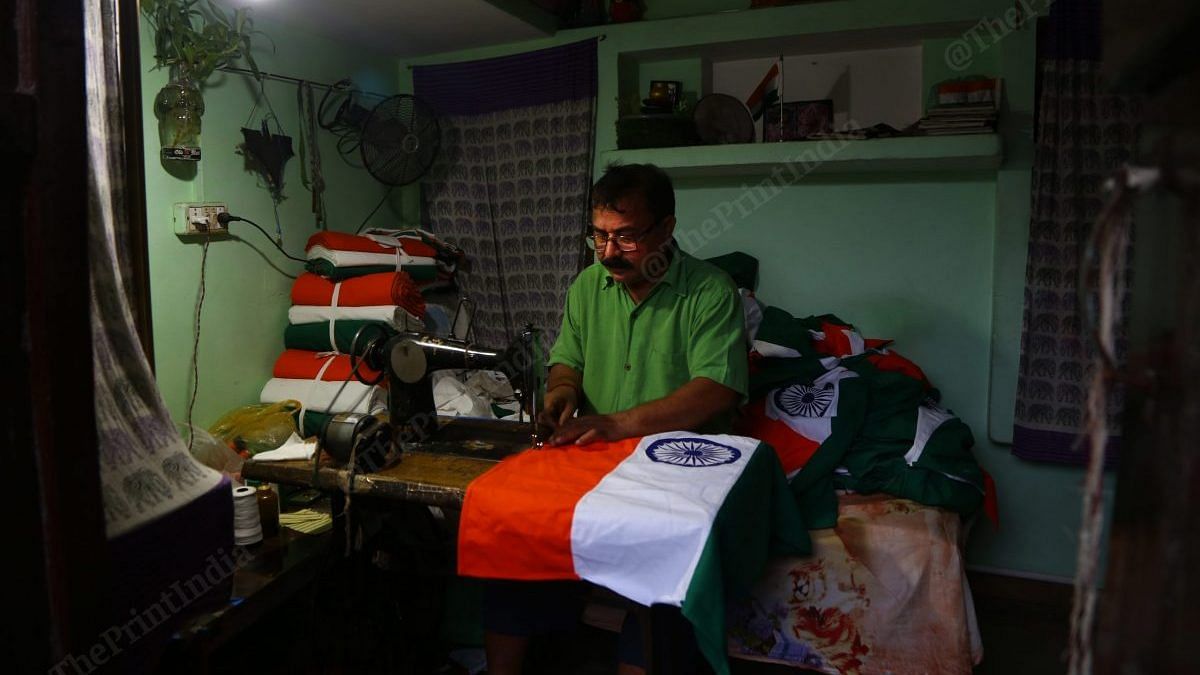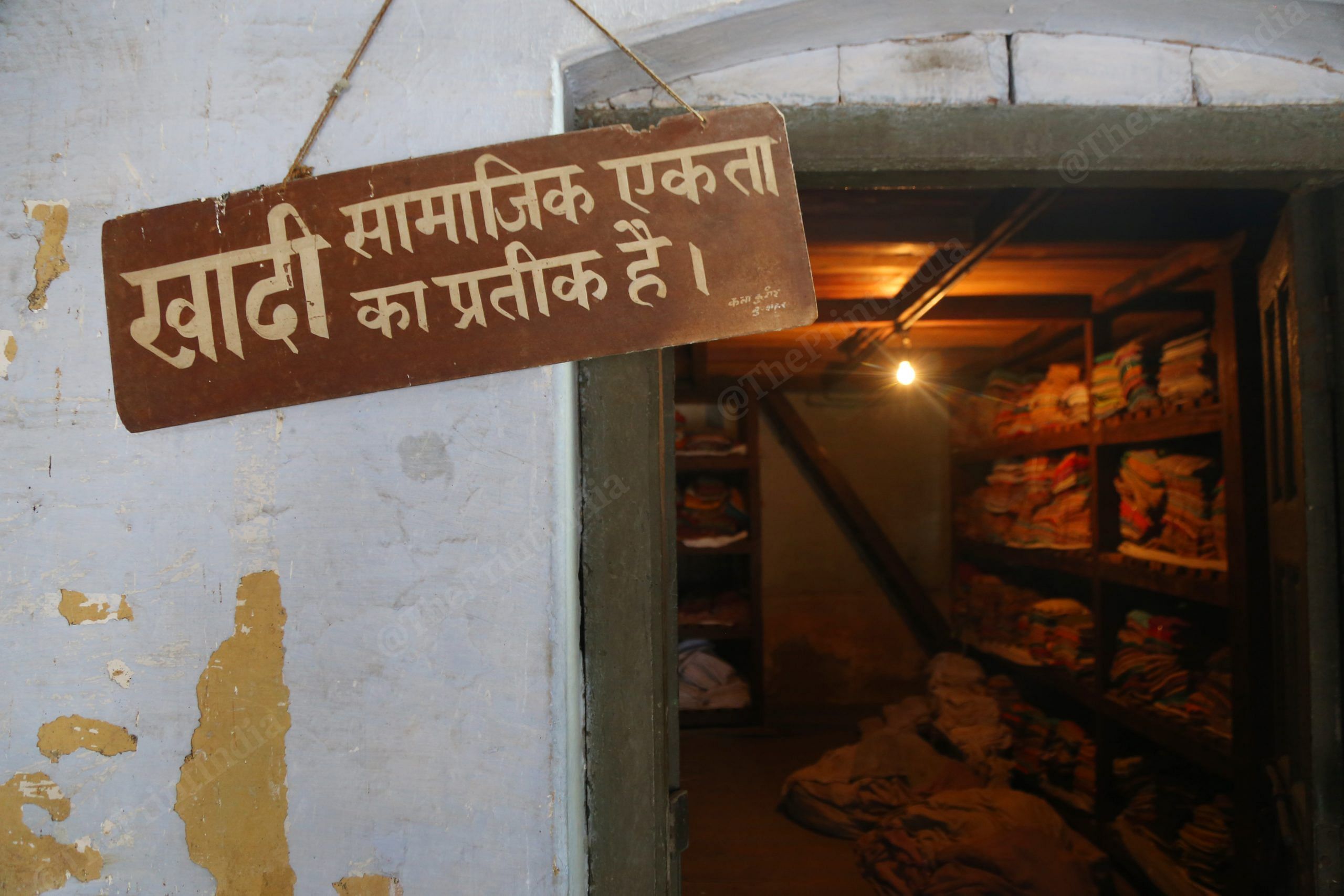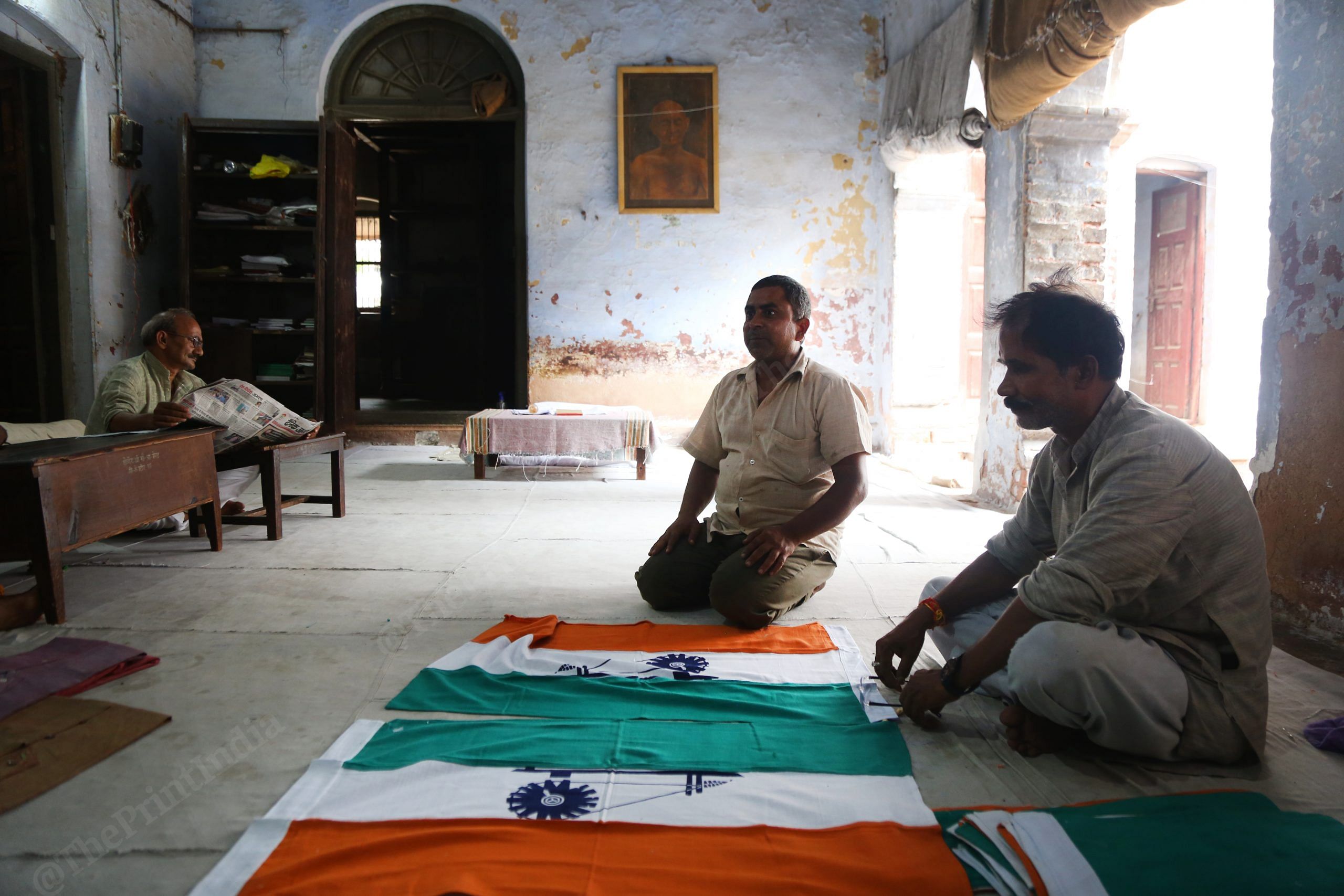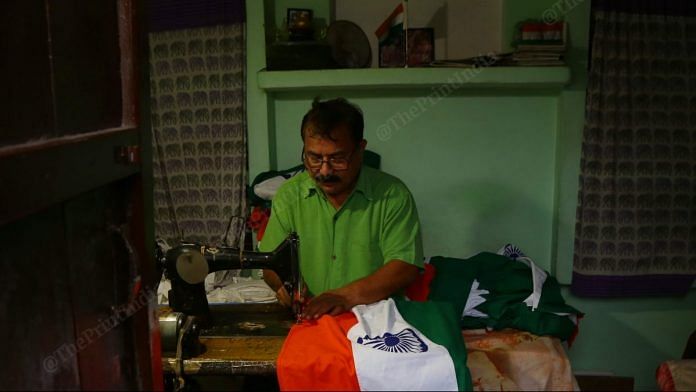Ramesh Chandra reaches for a strip of saffron khadi, carefully aligns it against the needle of his sewing machine, and stitches yet another Indian flag. He’s lost count of how many he’s sewed that day, week or month but it doesn’t matter. He’s got an important legacy to uphold.
From being the ‘sports city of India’ to the flourishing electronics industry, Meerut has lots of claims to fame. But the city’s connection to India’s national flag remains understated. Independent India’s first tiranga hoisted at Red Fort came from the Gandhi Ashram in Meerut—and it was stitched by Chandra’s father.
This year’s 75th Independence Day is being commemorated with ‘Har Ghar Tiranga’—an initiative by the Narendra Modi government to hoist the national flag in their homes. But here in Meerut, Ramesh’s family has been stitching 20 khadi flags a day well before the clock struck midnight on 15 August 1947, marking India’s “tryst with destiny”.
Chandra said that he’s been working towards the 75th-anniversary celebrations of India’s Independence, which has led to bulk orders of flags. “I’m running out of khadi to stitch,” he exclaimed.
A photo of B.R. Ambedkar occupies pride of place in his family’s sole bedroom, while a framed photo of Ramesh’s father—the original flag-stitcher—adorns his workroom.
“It’s a matter of pride for us that we’re stitching Indian flags,” said Chandra. “It feels really good to know that we are also doing something for the country. This is a historic thing. I’m proud that we are considered worthy to do this.”

Also Read: 175 dogs guard Assam’s pig heart doctor who bangs desk to speak. Patients still lining up
Flying the first flag
Chandra has been stitching khadi Indian flags for 42 years now—he started working with his father, Natthe Singh, at the age of 12. The family holds a contract from the nearby Gandhi Ashram to stitch khadi flags.
“This is the first time since my father’s era where there’s been such a high demand for Indian flags,” said Chandra, referring to his father’s heyday, which lasted through the 1950s and 1960s.
“I hold the contract now, after my father died,” said Chandra, “I don’t do anything else except stitching flags—this is my only job.” Not having workers makes his job harder, especially since he’s working to meet orders asking for over one lakh flags. “It’s not possible for one person to stitch so much.”
Chandra and his family live on the third floor of their family home. His workroom is stacked with reams of tricoloured khadi. A staircase winds through his brothers’ homes on the two floors below—one sells ‘poly’ (polyester) flags on the main road outside, while the other runs a juice shop adjacent. But only Chandra is carrying on their father’s heritage.
Natthe Singh, who died in 2019 at the age of 94, worked through the night on 13 August 1947, burning the midnight oil according to his son. The flag was then wrapped in mulmul and covered with flower petals, packed into a new box made with fresh wood, and carried by freedom fighters from Meerut to New Delhi.
The brand new flag was then unfurled at Red Fort, signifying a brand new India.
“Everyone knows about the tiranga,” said Chandra. “But not everyone knows who stitched the first one.”

Also Read: Andhra students won’t give up ‘American accent’, but barbaric bullying leaves them bruised
Khadi vs. ‘poly’ flags
Workers at the Gandhi Ashram—barely two kilometres away from Chandra’s home—aren’t so sure of Chandra’s esteemed legacy.
Even we have heard this story. But to be honest, we don’t have any documented proof that this happened,” said Prithvi Singh Rawat, who heads the Ashram. He agrees that it is highly likely that the flag was sent from Meerut—given its proximity to New Delhi—but errs on the side of caution when it comes to verifying Chandra’s legacy.
However, the story has spread through the city like folklore.
“We’ve heard this story! If it’s true, we’re proud that the first flag went from Meerut,” said a customer who had visited the ashram to buy a khadi kurta. Another customer said that while he was unaware of this story, he’s glad that Meerut played a part in such a historic moment.
The Gandhi Ashram has been selling flags for India since the freedom movement began, and even before the current tiranga was adopted in July 1947. Today, the dilapidated but regal red building houses a storeroom of khadi goods, which are sold to locals from a shop that opens to the noise of a main road in Meerut.
Until recently, the Indian flag was meant to be made out of khadi, and the right to manufacture the flag was held by the Khadi Development and Village Industries Commission. The commission allocated the task to regional groups like the Gandhi Ashram, which then further contracted workers like Chandra. However, an influx of cheaper and disposable flags made out of polyester and other such synthetic fabrics have flooded the market.
Chandra said that earlier, flags were made only from khadi and hoisted at state offices. The Flag Code of India, introduced in 2002, allowed private citizens to display the flag—so plastic flags became a popular choice.
Teluram—who is about to retire, having worked at the Gandhi Ashram for 40 years since 1982—says that he’s seen a consistent demand for khadi flags, sometimes so much so that they’re unable to meet it.
“These days poly flags are more common,” he said, “There is still a huge demand for genuine, authentic khadi flags, but people go for poly and plastic because it’s cheaper.” Khadi is naturally the most appropriate fabric for the flag because of its durability and its ties to the national movement, he adds.

Also Read: Savarkar broke monopoly of Nehru-Gandhi history books. Now there’s new appetite, wishlist
Another flagship claim from Hastinapur
An hour outside Meerut, in Hastinapur, lives a family with another connection to the Indian flag: This time, from colonial India.
Guru Nagar’s grandfather, Maj. Gen. Ram Nagar, was the top-ranking commander in Meerut in November 1946. He was supposedly in charge of arrangements at another historic event: The Indian National Congress’ last session before India’s Independence.
“This flag is not just part of our family history, it’s part of national history,” said Nagar. “My grandparents cared for it, my father looked after it, and now it’s our turn. We are very proud.”
This historic last session, hosted in Meerut, saw the hoisting of 9x14ft khadi tiranga with a full charkha at the centre. After the flag hoisting, Jawaharlal Nehru gave the flag to Nagar’s family for safekeeping.
Nagar’s family has been doing just that for three generations now and plans to continue guarding their national treasure. The flag is in near pristine condition and is carefully kept sealed in layers of cloth and plastic. It is regularly aired in the sun to prevent it from getting damp. It is currently with Nagar’s twin brother in Dehradun, who has been exploring different ways to preserve the fabric from decay.
“We’ve cared for this flag in the same way that we’ve cared for our son,” said Anju, Nagar’s wife. “And when he marries, I’ll make sure our daughter-in-law also has the same love and respect for it.”
The November 1946 session was the last session that the Congress held before India became Independent. Acharya Kriplani was the president, and the session was attended by Congressmembers like Sarojini Naidu, Sardar Vallabhbhai Patel, and the INA’s Shahnawaz Khan. The flag still carries the signature of Shahnawaz Khan, who was later elected to the Lok Sabha from Meerut several times.
(Edited by Srinjoy Dey)






